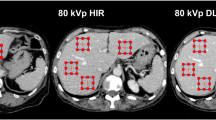Abstract
Objective
To evaluate the performance and reliability of the single-energy metal artifact reduction (SEMAR) algorithm in patients with different orthopedic hardware at the hips.
Materials and methods
A total of 153 patients with hip instrumentation who had undergone CT with adaptive iterative dose reduction (AIDR) 3D and SEMAR algorithms between February 2015 and October 2019 were included retrospectively. Patients were divided into 5 groups by the hardware type. Two readers with 21 and 13 years of experience blindly reviewed all image sets and graded the extent of artifacts and imaging quality using 5-point scales. To evaluate reliability, the mean densities and image noises were measured at the urinary bladder, veins, and fat in images with artifacts and the reference images.
Results
No significant differences were found in the mean densities of the urinary bladder, veins, and fat between the SEMAR images with artifacts (7.57 ± 9.49, 40.29 ± 23.07, 86.78 ± 38.34) and the reference images (7.77 ± 6.2, 40.27 ± 8.66, 89.10 ± 20.70) (P = .860, .994, .392). Image noises of the urinary bladder in the SEMAR images with artifacts (14.25 ± 4.50) and the SEMAR reference images (9.69 ± 1.29) were significantly higher than those in the AIDR 3D reference images (9.11 ± 1.12) (P < .001; P < .001). All AIDR 3D images were non-diagnostic (overall quality ≤ 3) and less than a quarter of the SEMAR images were non-diagnostic (16.7–23.7%), mainly in patients with prostheses [reader 1: 91.7% (22/24); reader 2: 92.6% (25/27)].
Conclusion
The SEMAR algorithm significantly reduces metal artifacts in CT images, more in patients with internal fixations than in patients with prostheses, and provides reliable attenuation of soft tissues.







Similar content being viewed by others
References
Veronese N, Maggi S. Epidemiology and social costs of hip fracture. Injury. 2018;49(8):1458–60.
Bhandari M, Swiontkowski M. Management of acute hip fracture. N Engl J Med. 2017;377(21):2053–62.
Deshmukh S, Omar IM. Imaging of hip arthroplasties: normal findings and hardware complications. Semin Musculoskelet Radiol. 2019;23(2):162–76.
Vande Berg B, Malghem J, Maldague B, Lecouvet F. Multi-detector CT imaging in the postoperative orthopedic patient with metal hardware. Eur J Radiol. 2006;60(3):470–9.
Katsura M, Sato J, Akahane M, Kunimatsu A, Abe O. Current and novel techniques for metal artifact reduction at CT: practical guide for radiologists. Radiographics. 2018;38(2):450–61.
Wellenberg RHH, Hakvoort ET, Slump CH, Boomsma MF, Maas M, Streekstra GJ. Metal artifact reduction techniques in musculoskeletal CT-imaging. Eur J Radiol. 2018;107:60–9.
Goodsitt MM, Christodoulou EG, Larson SC. Accuracies of the synthesized monochromatic CT numbers and effective atomic numbers obtained with a rapid kVp switching dual energy CT scanner. Med Phys. 2011;38(4):2222–32.
Yu L, Leng S, McCollough CH. Dual-energy CT-based monochromatic imaging. AJR Am J Roentgenol. 2012;199(5 Suppl):S9-s15.
Meinel FG, Bischoff B, Zhang Q, Bamberg F, Reiser MF, Johnson TR. Metal artifact reduction by dual-energy computed tomography using energetic extrapolation: a systematically optimized protocol. Invest Radiol. 2012;47(7):406–14.
Lewis M, Reid K, Toms AP. Reducing the effects of metal artefact using high keV monoenergetic reconstruction of dual energy CT (DECT) in hip replacements. Skeletal Radiol. 2013;42(2):275–82.
Grandmougin A, Bakour O, Villani N, et al. Metal artifact reduction for small metal implants on CT: which image reconstruction algorithm performs better? Eur J Radiol. 2020; 127:108970.
Barreto I, Pepin E, Davis I, et al. Comparison of metal artifact reduction using single-energy CT and dual-energy CT with various metallic implants in cadavers. Eur J Radiol. 2020; 133:109357.
Yasaka K, Maeda E, Hanaoka S, Katsura M, Sato J, Ohtomo K. Single-energy metal artifact reduction for helical computed tomography of the pelvis in patients with metal hip prostheses. Jpn J Radiol. 2016;34(9):625–32.
Sonoda A, Nitta N, Ushio N, et al. Evaluation of the quality of CT images acquired with the single energy metal artifact reduction (SEMAR) algorithm in patients with hip and dental prostheses and aneurysm embolization coils. Jpn J Radiol. 2015;33(11):710–6.
Gondim Teixeira PA, Meyer JB, Baumann C, et al. Total hip prosthesis CT with single-energy projection-based metallic artifact reduction: impact on the visualization of specific periprosthetic soft tissue structures. Skeletal Radiol. 2014;43(9):1237–46.
Kidoh M, Utsunomiya D, Ikeda O, et al. Reduction of metallic coil artefacts in computed tomography body imaging: effects of a new single-energy metal artefact reduction algorithm. Eur Radiol. 2016;26(5):1378–86.
Chou R, Li JH, Ying LK, Lin CH, Leung W. Quantitative assessment of three vendor’s metal artifact reduction techniques for CT imaging using a customized phantom. Comput Assist Surg (Abingdon). 2019;24(sup2):34–42.
Asai S, Sobue Y, Asai N, et al. Computed tomography evaluation of the periacetabular gap of a porous tantalum acetabular component. Nagoya J Med Sci. 2019;81(1):159–63.
Acknowledgements
The authors thank the Division of Medical Statistics and Bioinformatics, Department of Medical Research, Kaohsiung Medical University Hospital, Kaohsiung Medical University, for assistance with this study.
Author information
Authors and Affiliations
Corresponding author
Ethics declarations
Ethics approval
This study was approved by the Institutional Review Board of Kaohsiung Medical University Chung-Ho Memorial Hospital (IRB No: KMUHIRB-E(1)-20190447). Because of the retrospective nature, the requirement of informed consent was waived.
Conflict of interest
The authors declare no competing interests.
Additional information
Publisher's Note
Springer Nature remains neutral with regard to jurisdictional claims in published maps and institutional affiliations.
Rights and permissions
About this article
Cite this article
Chen, YH., Lu, CH., Chen, YJ. et al. Reliability and benefits of single-energy projection-based metallic artifact reduction (SEMAR) in the different orthopedic hardware for the hip. Skeletal Radiol 51, 1853–1863 (2022). https://doi.org/10.1007/s00256-022-04040-6
Received:
Revised:
Accepted:
Published:
Issue Date:
DOI: https://doi.org/10.1007/s00256-022-04040-6




